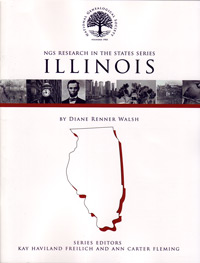“Illinois has had a longer and more interesting history than any other state west of the Alleghenies. It was not accidental that the white settlement of the mid-continent began on the east bank of the Mississippi River and that the largest non-coastal city took root and flourished at the southwestern corner of Lake Michigan. As geographical and geological heritages, the flat prairie has soil of unusual fertility, convenient water routes, and readily available mineral resources. Because of them, the settler came early, in increasing number, over several routes, and from varied national and racial backgrounds.”
This Issue: NGS Research in the States Series: Illinois; written by Diane Renner Walsh.
Illinois grew up from the beginnings of pioneers of diverse nationalities, including former African slaves. “The land they found was mostly prairie and likely appeared inhospitable at first to those more familiar with the rolling hills and valleys of the eastern states. Nevertheless, they soon found the land was fertile and crops flourished. Rivers, and later canals and railroads, facilitated movement within the state and led to settlement of large population areas.”
Extensive records exist, including online indexes and valuable search aids, to help researchers find their Illinois descendants. This guide is meant to help.
Each guide in this series offers a bit of history behind each type of record or resource as well as names and descriptions for specific archives. For example, in this volume under the heading Directories you will find the following:
“Residential directories are available for Chicago, Peoria, Rockford and Springfield and smaller cities. Chicago residents and registered voters are listed in a special 1937 directory. Some other locations have periodic county directories. Business directories were published between 1847 and 1860 by various publishers. Newberry Library and Chicago Historical Society have excellent collections; Family History Library has some directories on fiche or film.”
In the guide, each section is handled in like manner. Plenty of specific information on what records are available and where to find them.
About the Series
Beginning in 1987, the National Genealogical Society began publishing a series of state guides in the organization’s magazine, the Quarterly. These guides were later re-issued as special publications designed to support genealogical research in each state. Eventually those guides became outdated and out of print. The current set of guides represents a refresh of those publications, updated and improved for today’s traditional and digital research resources.
About the Author
Diane Renner Walsh is a certified genealogist, and more importantly, is consider to be an expert on Illinois research. She has won awards and recognition for her articles and her volunteer work. Her articles have appeared in publications including St. Clair County, Illinois Research and Resources: A Genealogist’s Guide as well as in the National Genealogical Society Quarterly.
More About the State Guides (from the Introduction)
“Readers should be aware that every effort has been made to include current web addresses throughout the publication and all were verified immediately prior to release…”
“Two research facilities used by many genealogists are the Family History Library (FHL) and the National Archives and Records Administration (NARA). Most genealogists are familiar with teh abbreviations used for these two facilities and they are used in these publications. Otherwise the use of abbreviations and acronyms is kept to a minimum.”
Table of Contents
History and Settlements
- American Period
Archives, Libraries, and Societies
- Online Sources
- Abraham Lincoln Presidential Library
- Chicago Historical Society
- Chicago Public Library
- Illinois Digital Archives
- Illinois Historical Survey
- Illinois Regional Archives Depository
- Illinois State Archives
- Illinois State Genealogical Society
- Illinois State Library
- National Archives — Great Lakes Region
- Other Libraries
Major Resources
- Atlases, Gazetteers, and Maps
- Place Names
- County Plats and Landownership Maps
- Transportation Guides
- Federal Township Plats
- Biographical Sources
- Business Records
- Cemetery Records
- Censuses and Census Substitutes
- French and Territorial Enumeration
- State Censuses
- Military Census
- Federal Schedules
- Church Records
- Court and Other Legal Records
- General Assembly
- Supreme Court and Appellate Courts
- Justice of the Peace Courts
- County Courts
- Circuit Courts
- Laws
- Directories
- Ethnic Records
- Land Records
- County Land Records
- Public Land Sales
- Land Granted before 1814
- Internal Improvements
- Military Tract
- Military and Veteran Records
- Eighteenth-Century Troops
- State Militia in Indian Wars and the National Guard
- Mexican War
- Civil War
- Spanish-American War
- World War and Later
- Soldier’s and Sailors’ Home
- Naturalization Records
- Newspapers
- Prison Records
- Religious Records
- School Records
- Tax Records
- Vital Records
- Adoption Records
- Birth and Death Records
- Marriage Records
- Divorce Records
- Women of Illinois
- Conclusion
These guides are an excellent resource for state by state research. Available guides, including NGS Research in the States Series: Illinois are available from Family Roots Publishing.
Other guides in series reviewed to date (in alphabetical order):
- NGS Research in the States Series: California
- NGS Research in the States Series: Indiana
- NGS Research in the States Series: Kentucky
- NGS Research in the States Series: Missouri
- NGS Research in the States Series: Nebraska
- NGS Research in the States Series: New York City, Long Island, and Westchester County
- NGS Research in the States Series: North Carolina
- NGS Research in the States Series: Ohio
- NGS Research in the States Series: Oklahoma
- NGS Research in the States Series: South Carolina
- NGS Research in the States Series: Tennessee
- NGS Research in the States Series: Virginia
- NGS Research in the States Series: West Virginia

At one point you published a way to use Ancestry.com in the original way. I hate the new structure and would love to revert back to the original. Can you tell me how to do it?
I have not used the site since they changed it over!